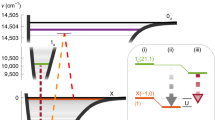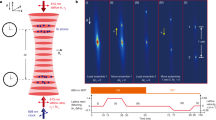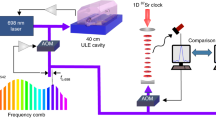Abstract
The 'magic wavelength' protocol has made it possible to design atomic clocks based on well-engineered perturbations. Such 'optical lattice clocks' will allow extremely high stability using a large number of atoms and fractional uncertainties of ∼10−18 by sharing particular 'magic' wavelengths. This Review covers the experimental realizations of such clocks, the optimal design of optical lattices and recent demonstrations of improved stability for large numbers of atoms. Possible impacts and future applications of optical lattice clocks are also discussed, such as testing the fundamental laws of physics and developing relativistic geodesy.
This is a preview of subscription content, access via your institution
Access options
Subscribe to this journal
Receive 12 print issues and online access
$209.00 per year
only $17.42 per issue
Buy this article
- Purchase on Springer Link
- Instant access to full article PDF
Prices may be subject to local taxes which are calculated during checkout






Similar content being viewed by others
References
Diddams, S., Bergquist, J., Jefferts, S. & Oates, C. Standards of time and frequency at the outset of the 21st century. Science 306, 1318–1324 (2004).
Hänsch, T. W. Passion for precision. Rev. Mod. Phys. 78, 1297–1309 (2006).
Hall, J. L. Defining and measuring optical frequencies. Rev. Mod. Phys. 78, 1279–1295 (2006).
Flowers, J. The route to atomic and quantum standards. Science 306, 1324–1330 (2004).
Schiller, S. et al. Einstein Gravity Explorer — a medium-class fundamental physics mission. Exp. Astron. 23, 573–610 (2009).
Steinmetz, T. et al. Laser frequency combs for astronomical observations. Science 321, 1335–1337 (2008).
Li, C.-H. et al. A laser frequency comb that enables radial velocity measurements with a precision of 1 cm s−1. Nature 452, 610–612 (2008).
Essen, L. & Parry, J. The caesium resonator as a standard of frequency and time. Phil. Trans. R. Soc. A 250, 45–69 (1957).
Heavner, T. P., Jefferts, S. R., Donley, E. A., Shirley, J. H. & Parker, T. E. NIST-F1: Recent improvements and accuracy evaluations. Metrologia 42, 411–422 (2005).
Bize, S. et al. Cold atom clocks and applications. J. Phys. B 38, S449–S468 (2005).
Young, B. C., Cruz, F. C., Itano, W. M. & Bergquist, J. C. Visible lasers with subhertz linewidths. Phys. Rev. Lett. 82, 3799–3802 (1999).
Gill, P. Optical frequency standards. Metrologia 42, S125–S137 (2005).
Dehmelt, H. G. Mono-ion oscillator as potential ultimate laser frequency standard. IEEE Trans. Instrum. Meas. IM-31, 83–87 (1982).
Nagourney, W., Sandberg, J. & Dehmelt, H. Shelved optical electron amplifier: Observation of quantum jumps. Phys. Rev. Lett. 56, 2797–2799 (1986).
Hänsch, T. W. & Schawlow, A. L. Cooling of gases by laser radiation. Opt. Commun. 13, 68–69 (1975).
Wineland, D. & Itano, W. Laser cooling of atoms. Phys. Rev. A 20, 1521–1540 (1979).
Udem, T., Reichert, J., Holzwarth, R. & Hänsch, T. W. Absolute optical frequency measurement of the cesium D1 line with a mode-locked laser. Phys. Rev. Lett. 82, 3568–3571 (1999).
Jones, D. J. et al. Carrier–envelope phase control of femtosecond mode-locked lasers and direct optical frequency synthesis. Science 288, 635–639 (2000).
Jones, T. Splitting the Second: The Story of Atomic Time (Taylor & Francis, 2000).
Itano, W. M. et al. Quantum projection noise: Population fluctuations in two-level systems. Phys. Rev. A 47, 3554–3570 (1993).
Paul, W. Electromagnetic traps for charged and neutral particles. Rev. Mod. Phys. 62, 531–540 (1990).
Itano, W. M. External-field shifts of the 199Hg+ optical frequency standard. J. Res. Natl Inst. Stand. Technol. 105 829–837 (2000).
Dicke, R. H. The effect of collisions upon the Doppler width of spectral lines. Phys. Rev. 89, 472–473 (1953).
Rosenband, T. et al. Frequency ratio of Al+ and Hg+ single-ion optical clocks: Metrology at the 17th decimal place. Science 319, 1808–1812 (2008).
Tamm, C., Weyers, S., Lipphardt, B. & Peik, E. Stray-field-induced quadrupole shift and absolute frequency of the 688-THz 171Yb+ single-ion optical frequency standard. Phys. Rev. A 80, 043403 (2009).
Chou, C. W., Hume, D. B., Koelemeij, J. C. J., Wineland, D. J. & Rosenband, T. Frequency comparison of two high-accuracy Al+ optical clocks. Phys. Rev. Lett. 104, 070802 (2010).
Katori, H. Spectroscopy of strontium atoms in the Lamb–Dicke confinement, in Proc. 6th Symp. on Frequency Standards and Metrology (ed. Gill, P.) 323–330 (World Scientific, 2002).
Verkerk, P. et al. Dynamics and spatial order of cold cesium atoms in a periodic optical potential. Phys. Rev. Lett. 68, 3861–3864 (1992).
Hemmerich, A. & Hänsch, T. W. Two-dimesional atomic crystal bound by light. Phys. Rev. Lett. 70, 410–413 (1993).
Phillips, W. D. Laser cooling and trapping of neutral atoms. Rev. Mod. Phys. 70, 721–741 (1998).
Katori, H., Ido, T. & Kuwata-Gonokami, M. Optimal design of dipole potentials for efficient loading of Sr atoms. J. Phys. Soc. Jpn. 68, 2479–2482 (1999).
McKeever, J. et al. State-insensitive cooling and trapping of single atoms in an optical cavity. Phys. Rev. Lett. 90, 133602 (2003).
Ye, J., Kimble, H. J. & Katori, H. Quantum state engineering and precision metrology using state-insensitive light traps. Science 320, 1734–1738 (2008).
Westbrook, C. I. et al. Localization of atoms in a three-dimensional standing wave. Phys. Rev. Lett. 65, 33–36 (1990).
Gordon, J. P. & Ashkin, A. Motion of atoms in a radiation trap. Phys. Rev. A 21, 1606–1617 (1980).
Cohen-Tannoudji, C. Manipulating atoms with photons. Rev. Mod. Phys. 70, 707–719 (1998).
Chu, S., Bjorkholm, J., Ashkin, A. & Cable, A. Experimental observation of optically trapped atoms. Phys. Rev. Lett. 57, 314–317 (1986).
Kaplan, A., Fredslund Andersen, M. & Davidson, N. Suppression of inhomogeneous broadening in rf spectroscopy of optically trapped atoms. Phys. Rev. A 66, 045401 (2002).
Katori, H., Takamoto, M., Pal'chikov, V. G. & Ovsiannikov, V. D. Ultrastable optical clock with neutral atoms in an engineered light shift trap. Phys. Rev. Lett. 91, 173005 (2003).
Porsev, S. G., Derevianko, A. & Fortson, E. N. Possibility of an optical clock using the 61S0–63P0 transition in 171,173Yb atoms held in an optical lattice. Phys. Rev. A 69, 021403 (2004).
Brusch, A., Le Targat, R., Baillard, X., Fouch, M. & Lemonde, P. Hyperpolarizability effects in a Sr optical lattice clock. Phys. Rev. Lett. 96, 103003 (2006).
Barber, Z. W. et al. Optical lattice induced light shifts in an Yb atomic clock. Phys. Rev. Lett. 100, 103002 (2008).
Hachisu, H. et al. Trapping of neutral mercury atoms and prospects for optical lattice clocks. Phys. Rev. Lett. 100, 053001 (2008).
Ido, T. & Katori, H. Recoil-free spectroscopy of neutral Sr atoms in the Lamb–Dick regime. Phys. Rev. Lett. 91, 053001 (2003).
Taichenachev, A. V. et al. Magnetic field-induced spectroscopy of forbidden optical transitions with application to lattice-based optical atomic clocks. Phys. Rev. Lett. 96, 083001 (2006).
Ovsiannikov, V. D. et al. Magic-wave-induced 1S0–3P0 transition in even isotopes of alkaline-earth-metal-like atoms. Phys. Rev. A 75, 020501 (2007).
Hong, T., Cramer, C., Nagourney, W. & Fortson, E. N. Optical clocks based on ultranarrow three-photon resonances in alkaline earth atoms. Phys. Rev. Lett. 94, 050801 (2005).
Santra, R., Arimondo, E., Ido, T., Greene, C. H. & Ye, J. High-accuracy optical clock via three-level coherence in neutral bosonic 88Sr. Phys. Rev. Lett. 94, 173002 (2005).
Yu, D. & Chen, J. Optical clock with millihertz linewidth based on a phase-matching effect. Phys. Rev. Lett. 98, 050801 (2007).
Ovsiannikov, V. D., Pal'chikov, V. G., Katori, H. & Takamoto, M. Polarisation and dispersion properties of light shifts in ultrastable optical frequency standards. Quant. Electron. 36, 3–19 (2006).
Degenhardt, C., Stoehr, H., Sterr, U., Riehle, F. & Lisdat, C. Wavelength-dependent ac Stark shift of the 1S0–3P1 transition at 657nm in Ca. Phys. Rev. A 70, 23414 (2004).
Ye, A. & Wang, G. Dipole polarizabilities of ns2S0 and nsnp3P0 states and relevant magic wavelengths of group-IIB atoms. Phys. Rev. A 78, 014502 (2008).
Petersen, M. et al. Doppler-free spectroscopy of the 1S0–3P0 optical clock transition in laser-cooled Fermionic isotopes of neutral mercury. Phys. Rev. Lett. 101, 183004 (2008).
Taichenachev, A. V., Yudin, V. I., Ovsiannikov, V. D., Pal'chikov, V. G. & Oates, C. W. Frequency shifts in an optical lattice clock due to magnetic-dipole and electric-quadrupole transitions. Phys. Rev. Lett. 101, 193601 (2008).
Katori, H., Hashiguchi, K., Il'inova, E. Y. & Ovsiannikov, V. D. Magic wavelength to make optical lattice clocks insensitive to atomic motion. Phys. Rev. Lett. 103, 153004 (2009).
Porsev, S. G. & Derevianko, A. Multipolar theory of blackbody radiation shift of atomic energy levels and its implications for optical lattice clocks. Phys. Rev. A 74, 020502 (2006).
Safronova, M. S. et al. Black-body radiation shifts and theoretical contributions to atomic clock research. IEEE Trans. Ultrason. Ferr. 57, 94–105 (2010).
Taichenachev, A. V., Yudin, V. I., Ovsiannikov, V. D. & Pal'chikov, V. G. Optical lattice polarization effects on hyperpolarizability of atomic clock transitions. Phys. Rev. Lett. 97, 173601 (2006).
Castin, Y. & Dalibard, J. Quantization of atomic motion in optical molasses. Europhys. Lett. 14, 761–766 (1991).
Lemonde, P. & Wolf, P. Optical lattice clock with atoms confined in a shallow trap. Phys. Rev. A 72, 033409 (2005).
Lemonde, P. Optical lattice clocks. Eur. Phys. J. Spec. Top. 172, 81–96 (2009).
Takamoto, M., Katori, H., Marmo, S. I., Ovsiannikov, V. D. & Pal'chikov, V. G. Prospects for optical clocks with a blue-detuned lattice. Phys. Rev. Lett. 102, 063002 (2009).
Gibble, K. & Verhaar, B. J. Eliminating cold-collision frequency shifts. Phys. Rev. A 52, 3370–3373 (1995).
Gibble, K. Decoherence and collisional frequency shifts of trapped bosons and fermions. Phys. Rev. Lett. 103, 113202 (2009).
Gupta, S. et al. Radio-frequency spectroscopy of ultracold fermions. Science 300, 1723–1726 (2003).
Akatsuka, T., Takamoto, M. & Katori, H. Optical lattice clocks with non-interacting bosons and fermions. Nature Phys. 4, 954–959 (2008).
Takamoto, M. & Katori, H. Coherence of spin-polarized fermions interacting with a clock laser in a Stark-shift-free optical lattice. J. Phys. Soc. Jpn. 78, 013301 (2009).
Takamoto, M. et al. Improved frequency measurement of a one-dimensional optical lattice clock with a spin-polarized fermionic 87Sr isotope. J. Phys. Soc. Jpn. 75, 104302 (2006).
Bernard, J. E., Marmet, L. & Madej, A. A. A laser frequency lock referenced to a single trapped ion. Opt. Commun. 150, 170–174 (1998).
Baillard, X. et al. Accuracy evaluation of an optical lattice clock with bosonic atoms. Opt. Lett. 32, 1812–1814 (2007).
Lisdat, C., Winfred, J., Middelmann, T., Riehle, F. & Sterr, U. Collisional losses, decoherence, and frequency shifts in optical lattice clocks with bosons. Phys. Rev. Lett. 103, 090801 (2009).
Courtillot, I. et al. Clock transition for a future optical frequency standard with trapped atoms. Phys. Rev. A 68, 30501 (2003).
Takamoto, M. & Katori, H. Spectroscopy of the 1S0–3P0 clock transition of 87Sr in an optical lattice. Phys. Rev. Lett. 91, 223001 (2003).
Takamoto, M., Hong, F. L., Higashi, R. & Katori, H. An optical lattice clock. Nature 435, 321–324 (2005).
Ludlow, A. D. et al. Systematic study of the 87Sr clock transition in an optical lattice. Phys. Rev. Lett. 96, 033003 (2006).
Le Targat, R. et al. Accurate optical lattice clock with 87Sr atoms. Phys. Rev. Lett. 97, 130801 (2006).
Campbell, G. K. et al. The absolute frequency of the 87Sr optical clock transition. Metrologia 45, 539–548 (2008).
Baillard, X. et al. An optical lattice clock with spin-polarized 87Sr atoms. Eur. Phys. J. D 48, 11–17 (2008).
Hong, F. L. et al. Measuring the frequency of a Sr optical lattice clock using a 120 km coherent optical transfer. Opt. Lett. 34, 692–694 (2009).
Lemke, N. D. et al. Spin-1/2 optical lattice clock. Phys. Rev. Lett. 103, 063001 (2009).
Kohno, T. et al. One-dimensional optical lattice clock with a fermionic 171Yb isotope. Appl. Phys. Exp. 2, 072501 (2009).
Campbell, G. K. et al. Probing interactions between ultracold fermions. Science 324, 360–363 (2009).
Beloy, K. Lattice-induced nonadiabatic frequency shifts in optical lattice clocks. Phys. Rev. A 82, 031402 (2010).
Ludlow, A. D. et al. Sr lattice clock at 1 × 10−16 fractional uncertainty by remote optical evaluation with a Ca clock. Science 319, 1805–1808 (2008).
Santarelli, G. et al. Frequency stability degradation of an oscillator slaved to a periodically interrogated atomic resonator. IEEE Trans. Ultrason. Ferr. 45, 887–894 (1998).
Quessada, A. et al. The Dick effect for an optical frequency standard. J. Opt. B 5, S150–S154 (2003).
Numata, K., Kemery, A. & Camp, J. Thermal-noise limit in the frequency stabilization of lasers with rigid cavities. Phys. Rev. Lett. 93, 250602 (2004).
Bize, S. et al. Interrogation oscillator noise rejection in the comparison of atomic fountains. IEEE Trans. Ultrason. Ferr. 47, 1253–1255 (2000).
Takamoto, M., Takano, T. & Katori, H. Frequency comparison of optical lattice clocks beyond the Dick limit. Nature Photon. (in the press).
Allan, D. Time and frequency (time-domain) characterization, estimation, and prediction of precision clocks and oscillators. IEEE Trans. Ultrason. Ferr. 34, 647–654 (1987).
Akatsuka, T., Takamoto, M. & Katori, H. Three-dimensional optical lattice clock with bosonic 88Sr atoms. Phys. Rev. A 81, 023402 (2010).
Santarelli, G. et al. Quantum projection noise in an atomic fountain: A high stability cesium frequency standard. Phys. Rev. Lett. 82, 4619–4622 (1999).
Jiang, Y. et al. Making optical atomic clocks more stable with 10−16 level laser stabilization. Preprint at http://arxiv.org/abs/1101.1351 (2011).
Kimble, H. J., Lev, B. L. & Ye, J. Optical interferometers with reduced sensitivity to thermal noise. Phys. Rev. Lett. 101, 260602 (2008).
Seel, S. et al. Cryogenic optical resonators: A new tool for laser frequency stabilization at the 1 Hz Level. Phys. Rev. Lett. 78, 4741–4744 (1997).
Meiser, D., Ye, J., Carlson, D. R. & Holland, M. J. Prospects for a millihertz-linewidth laser. Phys. Rev. Lett. 102, 163601 (2009).
Lodewyck, J., Westergaard, P. G. & Lemonde, P. Nondestructive measurement of the transition probability in a Sr optical lattice clock. Phys. Rev. A 79, 061401 (2009).
Uzan, J.-P. The fundamental constants and their variation: Observational and theoretical status. Rev. Mod. Phys. 75, 403–455 (2003).
Peik, E. et al. Limit on the present temporal variation of the fine structure constant. Phys. Rev. Lett. 93, 170801 (2004).
Blatt, S. et al. New limits on coupling of fundamental constants to gravity using 87Sr optical lattice clocks. Phys. Rev. Lett. 100, 140801 (2008).
Fortier, T. M. et al. Precision atomic spectroscopy for improved limits on variation of the fine structure constant and local position invariance. Phys. Rev. Lett. 98, 070801 (2007).
Angstmann, E. J., Dzuba, V. A. & Flambaum, V. V. Relativistic effects in two valence-electron atoms and ions and the search for variation of the fine-structure constant. Phys. Rev. A 70, 014102 (2004).
Bauch, A. & Weyers, S. New experimental limit on the validity of local position invariance. Phys. Rev. D 65, 081101 (2002).
Chou, C. W., Hume, D. B., Rosenband, T. & Wineland, D. J. Optical clocks and relativity. Science 329, 1630–1633 (2010).
Newbury, N. R., Williams, P. A. & Swann, W. C. Coherent transfer of an optical carrier over 251 km. Opt. Lett. 32, 3056–3058 (2007).
Bjerhammar, A. On a relativistic geodesy. J. Geod. 59, 207–220 (1985).
Acknowledgements
The author thanks M. Takamoto and T. Takano for useful discussions and careful reading of the manuscript.
Author information
Authors and Affiliations
Corresponding author
Rights and permissions
About this article
Cite this article
Katori, H. Optical lattice clocks and quantum metrology. Nature Photon 5, 203–210 (2011). https://doi.org/10.1038/nphoton.2011.45
Published:
Issue Date:
DOI: https://doi.org/10.1038/nphoton.2011.45
This article is cited by
-
Metallic local-moment magnetocalorics as a route to cryogenic refrigeration
Communications Materials (2024)
-
Free-space dissemination of time and frequency with 10−19 instability over 113 km
Nature (2022)
-
Resolution of the paradox of the diamagnetic effect on the Kibble coil
Scientific Reports (2021)
-
Observation of Feshbach resonances between a single ion and ultracold atoms
Nature (2021)
-
Quantum enhanced measurement of an optical frequency comb
npj Quantum Information (2021)



